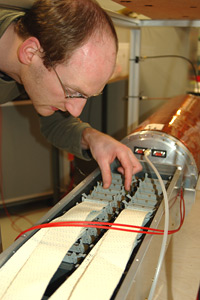 |
 |
|||||||||||||
|
|||||||||||||
|
|||||||||||||
|
In July, ILC NewsLine provided an overview of the Global Large Detector (GLD) concept. In October we took a closer look at the Silicon Detector (SiD) concept. This week features the third ILC detector concept LDC, and ILC NewsLine will continue its series about the four ILC detector concepts in the weeks to come. Next: 4th detector concept. With a concept called particle flow, experimenters at the ILC are getting philosophical. Particle flow, according to them, is the philosophy of event reconstruction. In the future ILC detectors, scientists will not rely on the classical event reconstruction methods of tracks in the tracker and energy dots in the calorimeter. They want more - a complete 3-D reconstruction of every charged and neutral particle that went through their carefully designed layers. One of these detectors is the Large Detector Concept or LDC, a group that has many European members, but also a large American and some Asian involvement. All four detector concepts have a similar general layout, but there are differences in focus and choice of technologies. The LDC is only of intermediate size – but of course size does not really matter, it is the precision that counts. LDC has set its focus on highly efficient precision tracking and precise granular calorimetry. The LDC tracking system consists of a time projection chamber (TPC) and a silicon tracker who together deliver more than 200 points per track. This will result in an improvement by a factor of 10 in track resolution, compared to current detectors. The vertex detector that will play an essential role in studying the Higgs, sits around the point where particles collide, recording everything that whizzes through with micron precision. The LDC's time projection chamber is surrounded by silicon-based trackers, adding both to the high aim of precision and the particle flow reconstruction method because they complement each other. "We need to be absolutely sure that we have reconstructed every particle," explains Ties Behnke, one of two European contact persons for the LDC. "The LDC has been optimised with this requirement in mind, especially, for charged particles, its tracking system. The combination of a TPC and silicon detectors is a particularly powerful tool to meet our goals." When in past detectors – or those that are being built for the LHC at the moment – a calorimeter "simply" measured the energy of a passing particle by way of looking at the total signal the particles left in the calorimeter, the ILC's calorimeters won't be satisfied with that. They want to provide 3D-images of the particles in the calorimeters as well. This, again, has to do with particle flow: the calorimeter becomes a "tracker" so that all particles that passed can be reconstructed -- particle by particle, charged and neutral, energy and direction. The way to do this is to make the calorimeter granular. This means high precision - many eyes to look at the location and direction of the particles – but it also means many readout channels and thus a high price tag. But the return in precision will be enormous: what sounds like a moderate improvement of a factor of two in jet energy resolution (going from 60%/√E to 30%/√E) actually corresponds to a massive increase in the physics potential of the experiment – and therefore the ILC. The forward region, the part of the detector that sits in the direction of the beam, has to deal with a lot of background, "particle noise" that comes from the collisions. Many computer-expert PhD students are working on software programs to study these backgrounds. The background isn't the only problem though. The forward region also has to be extremely radiation hard; yet another challenge for the 200 LDC-scientists. The planned detector will operate at a magnetic field of 4 Tesla. "We sought inspiration from CMS, so our coil resembles that of the LHC detector very closely," says Behnke. One detector research group is based in Saclay, France, where scientists did a lot of R&D for CMS and thus, according to Behnke, provided an optimal exchange of knowledge and experience. The muon system is inspired by the SLAC-based BaBar and thus not radically different from existing detector technologies. Between the four detector concepts, there is quite a lot of overlap in systems and scientists working on different things. "This is intentional," says Ties Behnke. "We are driven by technology and result, so it is absolutely useful for us to talk to and learn from each other." The LDC group has close ties to many of the different R&D collaborations like "Calorimeter for the Linear Collider Experiment" (CALICE), "Silicon detectors for a linear collider" (SiLC), "Linear Collider TPC group" (LC-TPC) or the forward region's FCAL group. -- Barbara Warmbein |
|||||||||||||
| © International Linear Collider |

